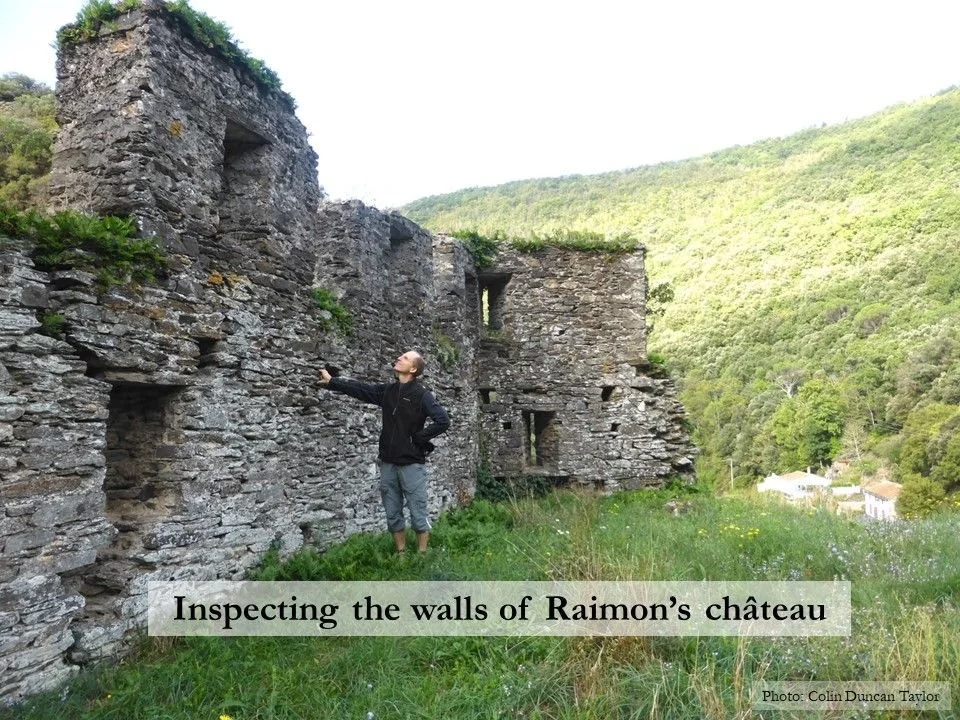Raimon de Miraval – the trials and tribulations of a 12th century troubadour
A castle mound surrounded by wooded mountain slopes. Forlorn sections of crumbling fortifications. A plaque informing any visitor who can read Occitan that the troubadour Raimon de Miraval was born here in the hamlet of Miraval-Cabardès sometime in the 12th century. The sign wouldn’t make anyone stop – unless they know his story.
Raimon de Miraval was a troubadour who truly lived his art. He was a knight so poor he only owned a quarter-share of this insignificant castle hidden in a lost valley of the Montagne Noire. He fell hopelessly in love with the wives of the two brothers who owned the bigger château next door, and in his old age he was tempted to come out of retirement in a bid to save the world, the Cathar world, from destruction by Simon de Montfort and his crusaders.
His life and works
Even the most basic details of Raimon’s life are intriguingly vague. He was born in 1135, or maybe 1160, or even 1165. He died in 1216, 1220, or perhaps 1229, aged somewhere between 51 and 94, probably at the monastery of Santa Clara in Lerida, Spain.
He wrote most of his troubadour songs between 1191 and 1213. Twenty-two of these compositions survive complete with lyrics and melodies, and they are still performed today. He was a frequent visitor to the court in Toulouse, where Count Raymond VI rewarded him with gifts of horses, arms and other finery.
Divorce and unrequited love
His romantic life was often a disaster. He divorced his wife Gaudairença, allegedly because she composed dances and it was too much to have two poets under one roof. After that, he composed his songs of courtly love for ladies who pleased him.
First came Etiennette de Pennautier. She was reputed to have a voracious appetite for men, and she is better known as Lady Loba, ‘loba’ being the Occitan for ‘she-wolf’. She was the wife of Jourdain de Cabaret who, with his brother Pierre-Roger, owned the eponymous château down the road above what is today called Lastours. In one song, Raimon beseeches her to return his love. Deaf to his entreaty, she chose instead to become the long-term mistress of the Count of Foix.
King Pedro II becomes a fan
After that setback, sometime around 1206 Raimon de Miraval turned his attention to Azalaïs de Boissézon, wife of the lord of Lombers. Azalaïs was a lady in search of fame, or at least notoriety, and she was delighted when such a famous troubadour agreed to write songs about her. Unfortunately for Raimon, he fell in love with her himself, but Azalaïs was aiming higher than a poor knight with a minority stake in a tiny château. She wanted to attract the attention of the King of Aragon. When she asked Raimon to extol her charms in a new song, our troubadour duly obliged and probably wished he hadn’t. When King Pedro II first heard the composition, he rushed hot-footed and hot-blooded all the way to Lombers, situated between Castres and Albi.
The destruction of the Château de Miraval
Poor Raimon soon consoled himself with the other noble spouse down the road at the château in Lastours. His songs about Lady Brunessen were more discreet, maybe because he was older and wiser, or perhaps because her husband, Pierre-Roger de Cabaret, was a powerful friend and protector. Unfortunately, the strength of this neighbour attracted the wrath of Simon de Montfort. In 1211, the crusaders marched up the valley past Lastours and destroyed Raimon de Miraval’s home. In his despair, our troubadour swore never to sing again until he had won it back.
The Battle of Muret
When he was in Toulouse two years later, Raimon wrote his final song. Perhaps remembering how one of his previous compositions had brought King Pedro rushing north to conquer Lady Azalaïs, Raimon de Miraval decided, or was persuaded, to write a song with a more political motive. He exhorts King Pedro to recapture the city of Carcassonne from the crusaders, and to make these invaders fear him as much as the Moors whom he had defeated a year earlier.
At the end of August, Pedro crossed the Pyrenees with a thousand knights from Aragon and Catalonia, and they joined up with the armies of the counts of Toulouse and Foix outside the town of Muret to the south of Toulouse.
Did Raimon de Miraval follow King Pedro and Count Raymond into battle? No one knows and it is difficult even to guess because, depending on which date of birth you favour, Raimon was somewhere between the ages of 48 and 78.
Defeat and exile
The crusaders won a crushing victory at Muret and Raimon went into exile on the other side of the Pyrenees. He never saw Miraval again, and if he wrote any more songs, they have not survived.




